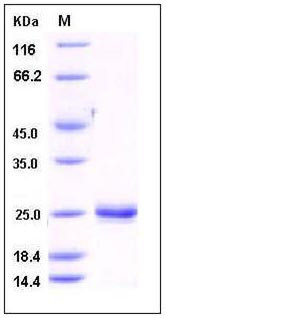Rat LCN2 / NGAL Protein (His Tag)
LCN2
- 100ug (NPP3081) Please inquiry
| Catalog Number | P80058-R08B |
|---|---|
| Organism Species | Rat |
| Host | Baculovirus-Insect Cells |
| Synonyms | LCN2 |
| Molecular Weight | The recombinant rat LCN2 comprises 188 amino acids with and has a predicted molecular mass of 21.9 kDa. It migrates as an approximately 25 kDa band in reduced SDS-PAGE. |
| predicted N | Gln 21 |
| SDS-PAGE |  |
| Purity | > 90 % as determined by SDS-PAGE |
| Protein Construction | A DNA sequence encoding the rat LCN2 (P30152) (Met 1-Asn 198) was fused with a polyhistidine tag at the C-terminus. |
| Bio-activity | Measured by its ability to bind Iron(III) dihydroxybenzoic acid [Fe(DHBA)3]. The binding of Fe(DHBA)3 results in the quenching of Trp fluorescence in Lipocalin2 . It binds >1.0 μM of Fe(DHBA)3. |
| Research Area | Immunology |Signal Transduction |Metabolism |Pathways and Processes |Redox metabolism |Fatty acid oxidation | |
| Formulation | Lyophilized from sterile 20mM Tris, 500mM NaCl, 10% glycerol, pH 7.0 1. Normally 5 % - 8 % trehalose and mannitol are added as protectants before lyophilization. Specific concentrations are included in the hardcopy of COA. |
| Background | Lipocalin-2 (LCN2), also known as neutrophil gelatinase-associated lipocalin (NGAL), is a 25 kDa protein belonging to the lipocalin superfamily. It was initially found in activated neutrophils, however, many other cells, like kidney tubular cells, may produce NGAL in response to various insults. This protein is released from injured tubular cells after various damaging stimuli, is already known by nephrologists as one of the most promising biomarkers of incoming Acute Kidney Injury (AKI). Recent evidence also suggests its role as a biomarker in a variety of other renal and non-renal conditions. Moreover, recent studies seem to suggest a potential involvement of this factor also in the genesis and progression of chronic kidney diseases. NGAL is the first known mammalian protein which specifically binds organic molecules called siderophores, which are high-affinity iron chelators. NGAL, first known as an antibacterial factor of natural immunity, and an acute phase protein, is currently one of the most interesting and enigmatic proteins involved in the process of tumor development. acting as an intracellular iron carrier and protecting MMP9 from proteolytic degradation, NGAL has a clear pro-tumoral effect, as has already been observed in different tumors (e.g. breast, stomach, oesophagus, brain) in humans. In thyroid carcinomas, NGAL is strongly induced by NF-kB, an important factor involved both in tumor growth and in the link between chronic inflammation and neoplastic development. Thus, Lipocalin-2 (LCN2/NGAL) has been implicated in a variety of processes including cell differentiation, proliferation, survival and morphogenesis. |
| Reference |
